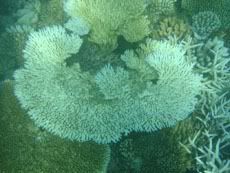
photo credit Minivan News via MRC
This is always a bad sign. The polyps and the zooxanthellae live in a mutually beneficial relationship, and (most times) the corals cannot survive without them. There are different levels of bleaching, but when an entire coral structure goes white, there is no chance of re-growth, and the reef begins to die. We all know coral reefs are hugely important ecosystems, so when the corals start to die, the damage ripples throughout the entire system.
Corals are sensitive to temperature change, and the recent high temperatures in the Maldives have been having an adverse effect.
"Hussein Zahir from the Marine Research Centre (MRC) has been collecting reports of the bleaching, and said that based on his estimates, “10-15 percent of shallow reef coral is now completely white, while 50-70 percent has begun to pale…Coral reefs may be the first ecosystem we’ll lose on our planet."
Full article here (Minivan News)
No comments:
Post a Comment